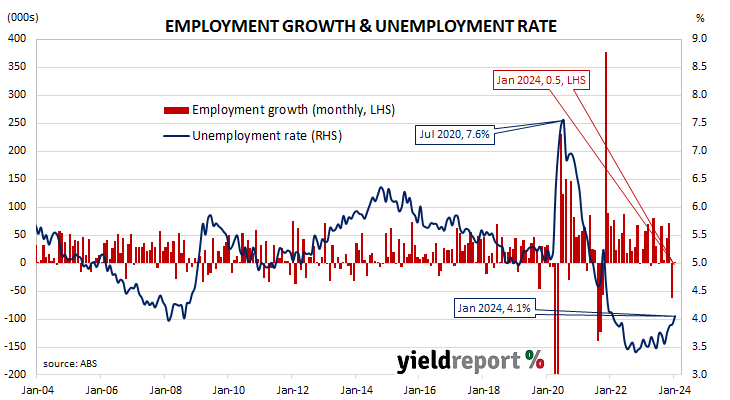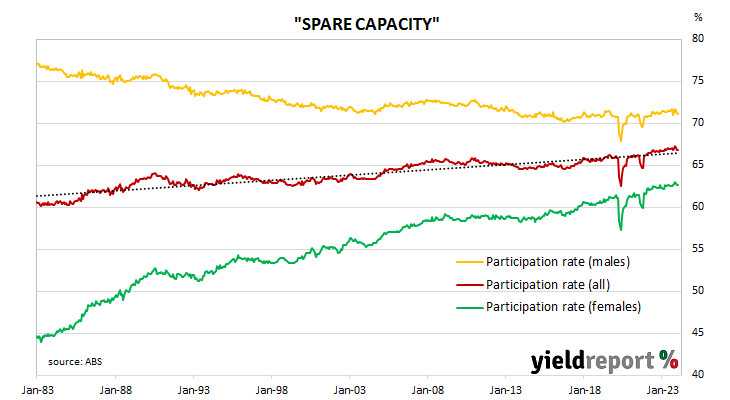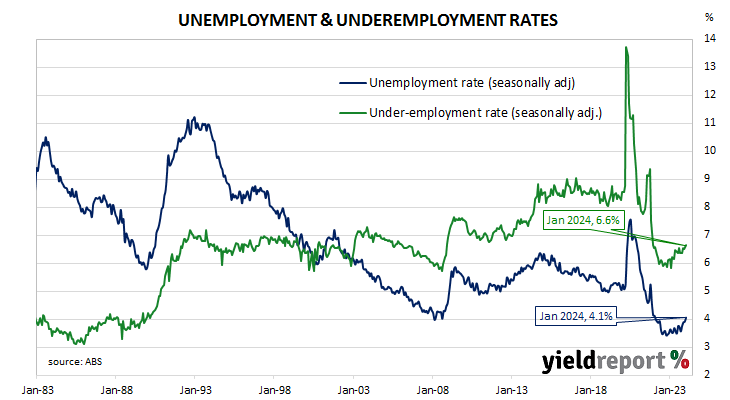Summary: Employment up 500 in January, considerably less than expectations; Westpac: January most seasonal time of year for labour market; Westpac: shifting seasonal dynamics likely played role in some of January’s weakness; ACGB yields fall significantly; rate-cut expectations firm; ANZ: suggests labour market may be slowing more sharply RBA forecast; participation rate steady at 66.8%; jobless rate rises from 3.9% to 4.1%; fewer part-time jobs, more full-time jobs; aggregate work hours down 2.5%; underemployment rate ticks up to 6.6%.
Australia’s period of falling unemployment came to an end in early 2019 when the jobless rate hit a low of 4.9%. It then averaged around 5.2% through to March 2020, bouncing around in a range from 5.1% to 5.3%. Leading indicators such as ANZ-Indeed’s Job Ads survey and NAB’s capacity utilisation estimate suggested the unemployment rate would rise in the June 2020 quarter and it did so, sharply. The jobless rate peaked in July 2020 but fell below 7% a month later and then trended lower through 2021 and 2022.
The latest Labour force figures have now been released and they indicate the number of people employed in Australia according to ABS definitions increased by just 500 in January. The result was considerably less than the 27,500 increase which had been generally expected but it also contrasted with December’s upwardly-revised loss of 62,800.
“January is the most seasonal time of the year for the labour market, and this year was no exception,” said Westpac economist Ryan Wells. “As we had anticipated, the softening trend in labour market conditions that extended into the new year was amplified by shifting seasonal dynamics that have become increasingly apparent in the years since the pandemic.”
Domestic Treasury bond yields fell significantly on the day, outpacing the falls of US Treasury yields overnight. By the close of business, 3-year and 10-year ACGB yield had both shed 13bps to 3.72% and 4.15% while the 20-year yield finished 11bp lower at 4.44%.
In the cash futures market, expectations regarding rate cuts later this year firmed. At the end of the day, contracts implied the cash rate would remain close to the current rate for the next few months and average 4.31% through March, 4.29% in April and 4.25% in May. However, August contracts implied a 4.125% average cash rate while November contracts implied 3.96%, 37bps less than the current rate.
“All in all, the results from the January survey were broadly consistent with our expectations,” Wells added. “Shifting seasonal dynamics likely played a role in some of January’s weakness, and similar to last year, this may give way to something of a rebound with respect to employment and hours worked in February.”
ANZ senior economist Blair Chapman sounded somewhat less positive about the result. “The data were weaker than expected and suggest the labour market may be slowing more sharply than the RBA had forecast. That said, January is a typically weak month and the number of employed leaving the labour force in January is elevated relative to pre-COVID levels.”
He also referred to the ABS note which observed there were more unemployed people than usual expecting to start a job shortly in addition to an elevated number of people taking leave in January. “The ABS’s seasonal adjustment processes may not be accounting for these changes in behaviour over recent years.”
The participation rate remained unchanged from December’s figure of 66.8% as the total available workforce increased by 22,800 to 14.802 million while the number of unemployed persons increased by 22,300 to 573,600. As a result, the unemployment rate rose from 3.9% to 4.1%.
The aggregate number of hours worked across the Australian economy fell by 2.5% as 10,600 residents lost part-time positions and 11,100 residents gained full-time positions. On a 12-month basis and after revisions, aggregate hours worked increased by 0.7% as 229,100 more people held part-time positions and 127,600 more people held full-time positions than in January 2023.
More attention has been paid to the underemployment rate in recent years, which is the number of people in work but who wish to work more hours than they do currently. January’s underemployment rate ticked up from December’s figure of 6.5% to 6.6%, 0.8 percentage points above this cycle’s low.
The underutilisation rate, that is the sum of the underemployment rate and the unemployment rate, has a strong correlation with the annual growth rate of the ABS private sector wage index when advanced by two quarters. January’s underutilisation rate of 10.7% corresponds with an annual growth rate of about 3.9%.




